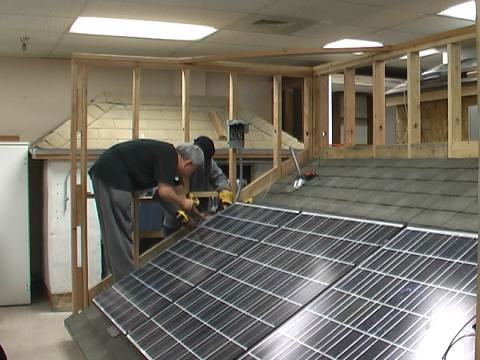Union leaders and volunteers from the Los Angeles County Federation of Labor gave Easter baskets to more than 200 children in need at the Children’s Institute in South Los Angeles on Friday.
An MTA bus carrying Easter baskets and, of course, life-size Mr. and Mrs. Easter Bunny, arrived at the Children’s Institute early Friday morning. All of the volunteers were wearing matching lavender shirts, some sporting stylish bunny ears and a cottontail.
Elated children, some wearing glittery paper bunny ears, gathered around Mr. And Mrs. Bunny as they sang songs and did the bunny hop. The Easter bunnies gave each child a basket filled with goodies–Barbie’s, my little ponies, racecars, motorcycles, crayons, sidewalk chalk, handballs and candy.
For the past 14 years, the Los Angeles County Federation of Labor, AFL-CIO’s Community Services Program and the United Way of Greater Los Angeles have distributed Easter baskets to homeless and abused children at more than 30 locations in the greater Los Angeles area. This is their ninth year at the Children’s Institute. Union leaders and workers come together to donate their time and resources to organize, fund and carry out the Easter event. More than $20,000 was raised to fund this year’s Easter events.
The Los Angeles County Federation of Labor, AFL-CIO is the second largest labor council in the country, representing more than 800,000 workers in over 350 unions. The Federation’s mission is to fight for good jobs that rebuild the middle class in Los Angeles.
Armando Olivas, the Western Regional Director for the Department of Labor Participation and the United Way of America, started the program in 1995 when he realized the only time of year the community came together to help children was Christmas.
“I thought that it would be a good idea to have another project for children because we don’t want them thinking that we forgot about them,” Olivas said. “So we came up with the spring project. We were naive in the beginning because we thought we would get a couple hundred baskets and drop them off but it just grew.”
Now the program donates more than 2,500 baskets to more than 30 locations across Los Angeles.
“Every year it’s renewed and you have a feeling of giving to somebody and it touches your heart,” Olivas said. “The first time we came out here the Easter bunny was in tears at how appreciative the children were.”
Olivas’ 8-year-old son, Matthew, described the event as “heartwarming.” He has been attending the annual Easter celebration for many years, but this year he joined the festivities as a volunteer, helping to bring joy to less fortunate children on Easter.
“Homeless children get what they want and they now have a good thought in their hearts,” Matthew said.
Glen Rosales, a Metro Mechanic Union Representative, said in his six years participating in the program, the best part is seeing the children smile.
“We did Miller Children’s hospital [Long Beach] and there was a little girl maybe 18 months old with cancer…and she ran down the hall so fast to hug the bunny,” Rosales said. “You think you’re having a bad day then you see something like that and it’s all worth it.”
According to Director of Communications for the CII, Lizanne Flemming, the Children’s Institute was founded in 1906 when the first female probation officer in Los Angeles, Minnie Barton, started taking women who were jailed or on the streets into her home. The program evolved over the years into an organization that makes sure vulnerable adults and children are taken care of. Their main emphasis, she said, is on children who have experienced some form of trauma.
“As the employees, it’s magical for us. We drop what we’re doing and greet the volunteers and you see the kids and the joy is just contagious,” Flemming said. “You can’t help it and the excitement when two big bunnies come into your play yard, it doesn’t get better than that.”















